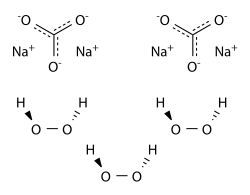Sodium percarbonate
 | |
 | |
| Names | |
|---|---|
| IUPAC name
sodium carbonate—hydrogen peroxide (2/3) | |
| Other names
sodium carbonate sesquiperhydrate, PCS, solid hydrogen peroxide, Sodium carbonate hydrogen peroxide, sodium carbonate peroxyhydrate | |
| Identifiers | |
| 15630-89-4 | |
| ChemSpider | 13399092 |
| EC number | 239-707-6 |
| |
| Jmol-3D images | Image |
| PubChem | 159762 |
| RTECS number | FG0750000 |
| |
| UNII | Z7G82NV92P |
| Properties | |
| Na2CO3·1.5H2O2 | |
| Molar mass | 156.982 g/mol |
| Appearance | white solid |
| 150 g/l | |
| Hazards | |
| Main hazards | Irritant, Oxidizer |
| EU Index | Not listed |
| Flash point | Non-flammable |
| Related compounds | |
| Other anions |
Sodium carbonate Sodium bicarbonate |
| Other cations |
Calcium percarbonate Magnesium percarbonate |
| Related compounds |
Sodium perborate Sodium persulfate Sodium perphosphate |
| Except where noted otherwise, data is given for materials in their standard state (at 25 °C (77 °F), 100 kPa) | |
| | |
| Infobox references | |
Sodium percarbonate is a chemical, an adduct of sodium carbonate and hydrogen peroxide (a perhydrate), with formula 2Na2CO3 · 3H2O2. It is a colorless, crystalline, hygroscopic and water-soluble solid.[1] It is used in some eco-friendly cleaning products and as a laboratory source of anhydrous hydrogen peroxide.
This product contains the carbonate anion, and should not be confused with sodium peroxocarbonate Na2CO4 or peroxodicarbonate Na2C2O6, which contain different anions.
Structure
At room temperature, solid sodium percarbonate has the orthorhombic crystal structure, with the Cmca crystallographic space group. The structure changes to Pbca as the crystals are cooled below about −30 °C.[2]
Production
Sodium percarbonate is produced industrially by reaction of sodium carbonate and hydrogen peroxide, followed by crystallization. Also, dry sodium carbonate may be treated directly with concentrated hydrogen peroxide solution. World production capacity of this compound was estimated at several hundred thousand tonnes for 2004.[3] It can be obtained in the laboratory by treating the two substances in aqueous solution with proper control of the pH[4] or concentrations.[2]
Uses
As an oxidizing agent, sodium percarbonate is an ingredient in a number of home and laundry cleaning products, including non-chlorine bleach products such as OxiClean, Tide laundry detergent,[1] and Vanish.[5] Dissolved in water, it yields a mixture of hydrogen peroxide (which eventually decomposes to water and oxygen) and sodium carbonate ("soda ash").[1]
- 2Na2CO3.3H2O2 → 2Na2CO3 + 3H2O2 [5]
Sodium percarbonate can be used in organic synthesis as a convenient source of anhydrous H2O2, in particular in solvents that cannot dissolve the carbonate but can leach the H2O2 out of it.[6]
Commercial products
References
- ↑ 1.0 1.1 1.2 Craig W. Jones (1999). Applications of hydrogen peroxide and its derivatives. Royal Society of Chemistry. ISBN 0-85404-536-8.
- ↑ 2.0 2.1 R. G. Pritchard and E. Islam (2003). "Sodium percarbonate between 293 and 100 K". Acta Crystallographica Section B B59 (5): 596–605. doi:10.1107/S0108768103012291.
- ↑ Harald Jakob, Stefan Leininger, Thomas Lehmann, Sylvia Jacobi, Sven Gutewort (2005), "Peroxo Compounds, Inorganic", Ullmann's Encyclopedia of Industrial Chemistry, Weinheim: Wiley-VCH, doi:10.1002/14356007.a19_177.pub2
- ↑ J. M. Adams and R. G. Pritchard (1977). "The crystal structure of sodium percarbonate: an unusual layered solid". Acta Crystallographica Section B B33 (12): 3650–3653. doi:10.1107/S0567740877011790.
- ↑ 5.0 5.1 "Oxygen-based bleaches", The Royal Society of Chemistry, and Reckitt Benckiser (the manufacturers of Vanish)
- ↑ McKillop, A (1995). "Sodium perborate and sodium percarbonate: Cheap, safe and versatile oxidising agents for organic synthesis". Tetrahedron 51 (22): 6145. doi:10.1016/0040-4020(95)00304-Q.
External links
- Organic Chemistry Portal: Sodium percarbonate
- Record in the Household Products Database of NLM